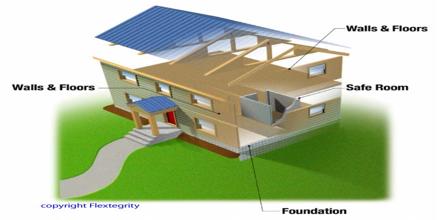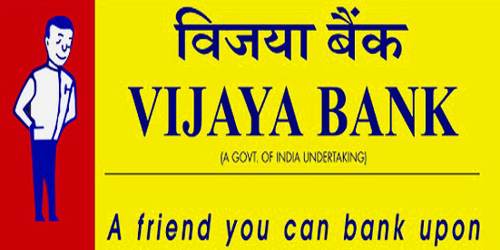Reducing community risk through
disaster resilient housing in Bangladesh
Bangladesh is most vulnerable to various natural disasters and is a known cause of distress among its people. The major disasters concerned here are the occurrences of flood, cyclone and storm surge, flash flood, drought, tornado, riverbank erosion, and landslide. These extreme natural events are termed disasters when they adversely affect the whole environment, including human beings, their shelters and the resources essential for their livelihoods. The communities in the disaster prone areas of the country, especially the poor are the most affected by it and suffer great loss as they cannot easily go back to the pre-disaster condition. Hence, it becomes important to build communities resilient to disasters to reduce their vulnerability and risk. As stated in DEPICHO:
―Bangladesh is one of the most disaster-prone countries in the world, suffering from regular floods, cyclones, earthquakes and drought. It is estimated that in the past 20 years, 135 million people in Bangladesh have been affected by natural disasters, and while many have lost their lives or been injured, millions of others have also lost their homes, land and livelihoods‖ (DEPICHO, 2012, p.1).
Although disasters have a huge impact on people‘s lives, it has larger impact on their shelter. Disaster events disrupt day to day life and leave the families without proper housing and results in lack of access to basic services such as water and sanitation. Since this is one of the key assets to the community people, the damage makes it difficult for them to recover from the loss. Housing or shelter is considered one among three basic human needs next to food and clothing.
The importance of housing should not be understated since it is a key aspect of a person‘s health, wellbeing, and prospects in life. ―Housing cannot be merely seen as a living and infrastructure/facilities function, but also as settlement process and as facilities for people to communicate with the environment (neighborhood, society, nature surroundings)‖ (ADPC, 2011).
Disaster risk reduction (DRR) offers a major contribution to the building of safer, resilient communities. Central to this is the focus on communities and specific zones that are at risk from frequent disaster impacts. The UNISDR defines resilience as:
―The ability of a system, community or society exposed to hazards to resist, absorb, accommodate to and recover from the effects of a hazard in a timely and efficient manner, including through the preservation and restoration of its essential basic structures and functions‖ (UNISDR, 2009, p.24).
Resilience and the building of resilience should therefore be seen as an integral part of disaster risk reduction activities.
―Resilient Housing‖ is an alternative approach in disaster risk reduction targeting the most vulnerable communities. ―It has been argued that designing and constructing a resilient built environment demands an in-depth understanding of the expertise and knowledge of avoiding and mitigating the effects of threats and hazards‖ (Little, 2004; Hamelin and Hauke, 2005) ―and that the most influential disciplines that can affect the resilience of the built environment are the design, engineering and construction discipline‖ (Bosher et al., 2007). Therefore through careful architectural planning and construction practices we can develop resilient housing in the disaster prone areas where the communities are most at risk of losing their homes. The use of disaster resilient materials and structures should be considered which can help minimize severe damage and loss.
This study focuses on exploring the means and methods through which risk to communities can be reduced through disaster resilient housing which will eventually reduce the severe impact of the disasters as well. Through this study some basic design considerations, construction practices, social and administrative issues are laid out to be considered for construction practice in Bangladesh.
Statement of Problem
Bangladesh is a multi-hazardous and disaster prone country. Every year, recurring disasters like flood, cyclone and landslides upset lives of the rural community people and adversely affect the environment (DEPICHO, 2012). Housing among the others is facing greater challenges due to natural hazards and uncontrolled urbanization in Bangladesh. However, there seems to be a lack of overall housing solutions for building disaster resilient structures in the hazard exposed areas that address future disaster risks. Inappropriate housing solutions together with poorly constructed houses are considered as one of the main sources of risks to disasters (Tran et al., 2012). The housing sector of the country tends to focus more on the physical improvement with little attention to the administrative and social issues. Shelter is one of the basic needs of human survival (Newaz, 2004). Having a home safe from natural hazards is very important in the disaster prone areas. Therefore exploring means to reduce community risk through a resilient housing system is now a vital issue.
Analyzing existing literature, I was convinced that there needs to be appropriate legal frameworks and supportive programs in order to improve local construction and to build safer and more resilient communities. Through the integration of disaster risk reduction (DRR) in the housing system, community resilience can be achieved and damage minimized. This was the motivation behind conducting a study to explore different approaches for mainstreaming DRR in the housing practice in Bangladesh.
Objectives of the Research
- To identify how the existing separation between risk reduction and housing can be overcome, and integration achieved.
- To explore ways in which resilience can be achieved through housing practices in the disaster prone areas.
- To explore different disaster resilient design approaches and structures that could be used in housing practices to reduce community risk in the disaster prone areas.
Research Questions
- Will mainstreaming disaster risk reduction into housing practices in the disaster prone areas build a resilient community to disaster in the Bangladesh context?
- How can disaster resilient housing contribute to reduce the vulnerability of the community people?
Community, Community Risks and Vulnerabilities
The word “community” is derived from the old French communité, a broad term for fellowship or organized society. The term community has two distinct meanings; one is a group of interacting people, living in some proximity (i.e., in space, time, or relationship) and the other usually refers to a social unit larger than a household that shares common values and has social cohesion. In conventional emergency management, communities are viewed in spatial terms: groups of people living in the same area or close to the same risks (Twigg, 2007).
It is common that the people at the community level have more to lose because they are the ones directly hit by disasters, whether on a big scale or on a small scale. They are the first ones to become vulnerable to the effects of such hazardous events. The community, therefore, has a lot to lose if they do not address their own vulnerability. On the contrary, they have the most to gain if they can reduce the impact of disasters on their community. The local people of a disaster prone area, due to exposure and proximity, are the victims and assume most of the responsibilities in coping with effects of disasters. They have local knowledge of vulnerabilities and are repositories of any traditional coping mechanisms suited to their own environment. In addition, these people are the first responders in times of crisis whereas the last remaining participants as stricken communities strive to rebuild after a disaster.
People with vulnerabilities are more susceptible to the immediate, medium and long- term effects of disasters such as loss, injury, social dislocation and economic hardship. Vulnerability may depend on a number of factors, such as personal health, location or socioeconomic situation.
People who require special or significant assistance to mitigate against, prepare for, respond to and recover from a disaster should be considered vulnerable. Vulnerability diminishes the capacity of an individual or group to anticipate, cope with, resist and recover from the impact of a natural or man-made hazard. Vulnerable groups are also those that also find it hardest to reconstruct their livelihoods following disaster, and this in turn makes them more vulnerable to the effects of subsequent hazard events (Sadeka et al., 2013). Being poor contribute a lot to being vulnerable because they face many risks and pressures that limit their ability to improve their livelihoods and wellbeing. Though disasters affect everyone, often the impact disproportionately falls on poor communities and the poor and marginalized people within. The effects of natural disasters can be persistent for the poor, especially when they lose both of income and assets (Noy, 2009). Poverty restricts these community people from having alternate or diversified livelihood options. They have limited or almost no access to funding or financial assistance for which they are usually dependent on one kind of livelihood which when damaged by a disaster event becomes difficult to recover.
Household assets are the important assets which include land, livestock, productive assets, appliances, and non-productive assets. The poor and vulnerable do not have the assets necessary to generate stable income and maintain a healthy quality of life. Only very few rural households own agricultural land. Vulnerable and highly vulnerable households are overwhelmingly landless. Therefore their household assets are vulnerable to any natural hazard and once they are damaged, they can hardly recover the loss.
Concept of Resilience
The term resilience is often used in the same manner as the notion of ―bouncing back‖ that reflects its Latin root ―resiliere‖ which means ―to jump back‖ (Klein et al., 2003; Paton & Johnston, 2006). Different scholars/organizations have defined resilience by different perspective. Here resilience is considered with the perspective of disaster or hazard event. International Strategy for Disaster Reduction (ISDR) defines resilience as ―the capacity of a system, community or society that is potentially exposed to a hazard, to adapt to it by resisting changing so that it reach and maintain an acceptable level of functioning and structure‖ (Sadeka et al., 2013). UNISDR also define as ―the ability of a system, community or society exposed to hazards to resist, absorb, accommodate to and recover from the effects of a hazard in a timely and efficient manner‖ (UNISDR, 2007).
‗Resilience‘ is generally seen as a broader concept than ‗capacity‘ because it goes beyond the specific behavior, strategies and measures for risk reduction and management that are normally understood as capacities. However, it is difficult to separate the concepts clearly. In everyday usage, ‗capacity‘ and ‗coping capacity‘ often mean the same as ‗resilience‘. A focus on resilience means putting greater emphasis on what communities can do for themselves and how to strengthen their capacities, rather than concentrating on their vulnerability to disaster or their needs in an emergency. The terms ‗resilience‘ and ‗vulnerability‘ are opposite sides of the same coin, but both are relative terms as argued by Manyena (2006). One has to ask what individuals, communities and systems are vulnerable or resilient to, and to what extent. Like vulnerability, resilience is complex and multifaceted. Different features or layers of resilience are needed to deal with different kinds and severity of stress.
As defined by Chandra et al. (2011), Community resilience involves enhancing the capacity of the community to account for its vulnerabilities and grow capabilities that support the community in preventing, withstanding, and mitigating the stress of a hazard incident; recovering in a way that restores the community to a state of self-sufficiency and using knowledge from a past response to strengthen the community‘s ability to withstand the next hazard incident.
The ‗disaster-resilient community‘ is an ideal. Communities can never be completely safe from natural and man-made hazards. It may be helpful to think of a disaster-resilient or disaster resistant community as ‗the safest possible community that we have the knowledge to design and build in a natural hazard context‘, minimizing its vulnerability by maximizing the application of DRR measures. DRR is therefore the collection of actions, or process, undertaken towards achieving resilience.
The component of resilience is a broad concept and hence is divided into five thematic areas relating to resilience and DRR. The five thematic areas are based on those in the Hyogo Framework for Action and are intended to cover all aspects of resilience (Twigg, 2007).
Table: Components of Resilience
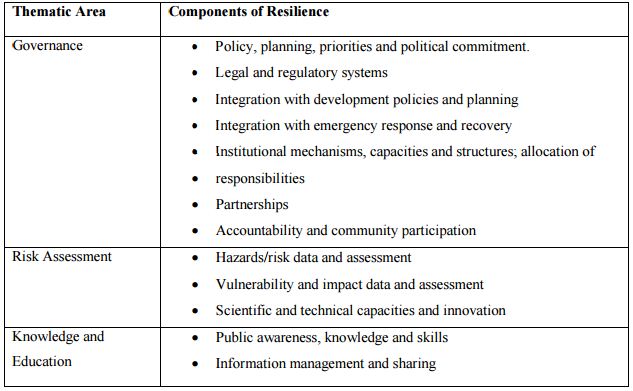

Concept of Disaster Risk Reduction (DRR)
The Evolution of Disaster Risk Reduction:
The concept of Disaster Risk Reduction (DRR) has evolved in the last decade to a widely adapted framework to reduce the risks of natural hazards. Over the past decades, the UN International Decade for Natural Disaster, the Yokohama Conference (1994) and the World Conference on Disaster Risk Reduction (WCDR) in 2004 have contributed to a significant shift in the understanding of disaster management towards a more comprehensive understanding of the underlying causes of hazards and vulnerability and towards the development of a forward looking and longer term strategy for anticipating and managing risk; in other words, a change of the concept of vulnerability and hazards by drawing more attention to the underlying causes of increased social vulnerability to hazards. During this time, the today used concept of Disaster Risk Reduction was developed giving particular emphasis on proactive measures (prevention and preparedness) instead of being reactive to disasters.
Yokohama Strategy and Plan of Action:
On the occasion of the 1994 mid-term review of the IDNDR (International Decade for Natural Disaster Reduction), the World Conference on Natural Disaster Reduction was held in Yokohama. Since then, the Yokohama Strategy for a Safer World: Guidelines for Natural Disaster Prevention, Preparedness and Mitigation and its Plan of Action, unanimously adopted by the participants of the Conference, has served as the international blueprint for disaster reduction.
Since 1994 the human and economic losses due to natural disasters have continued to increase despite efforts undertaken during the IDNDR and, later, under the umbrella of the International Strategy for Disaster Reduction (ISDR), the United Nations programme established in 2000 to follow on the IDNDR achievements.
Hyogo Framework for Action (HFA):
A cornerstone of DRR is the Hyogo Framework for Action (HFA) (2005-2015) elaborated at the World Conference on Disaster Reduction in Kobe, Hyogo (Japan). Adopted by 168 countries, its overarching goal is to build the resilience of nations and communities to disasters by achieving substantive reduction of disaster losses by 2015. The framework is organized according to five priorities for action (UNISDR, 2005)
DISASTER AND HOUSING IN BANGLADESH
Major Hazards and Disasters in Bangladesh
Bangladesh is a disaster risk hotspot, ranked with the highest disaster risks. This reflects the very profound, multi-layered challenges that the country face. Bangladesh is prone to floods and cyclones, and the risk of other disasters such as drought, earthquakes, landslides and tornados is increasing. The impacts are becoming more visible at the local level, with greater impacts on poor and vulnerable communities. Population density and poverty run hand in hand to increase vulnerability. Poor people in a crowded country like Bangladesh have limited options: they live in areas prone to cyclones, flooding or landslides, with their homes, life and livelihood against the forces of nature. Some of the frequent natural hazards are discussed in this chapter.
Cyclone
The Bay of Bengal is called a breeding ground for tropical cyclones and in terms of fatalities and economic losses; Bangladesh is one of the worst victims. The funnel shaped coast line and particularly the low topography make the coastal area subject to high surge associated with cyclones. The global distribution of cyclones shows that only 1 % of all cyclones that form every year strike Bangladesh; but unfortunately the fatalities they cause account for 53 % of the global total (Ali, 1999). Records show that 16 out of 35 of the tropical cyclones worldwide that caused deaths of more than 5,000, occurred in Bangladesh (SMRC, 1998). According to the Multipurpose Cyclone Shelter Programme report, 6.4 % of the country is considered High Risk Area where the surge height may exceed 1 m.
A number of cyclones have devastated Bangladesh causing hundreds of thousands of human deaths. Apart from the human casualties, cyclones have caused substantial damage to properties, which include physical infrastructure, livelihoods means and various direct tangible/intangible and indirect tangible/intangible items. It is very difficult to frame the continuum of loss and damage caused by these disaster events; it transcends the spatial and temporal boundaries. Since the livelihood activities of the poor people are localized, the population exposed to the risk of cyclones cannot afford shifting their settlements to a safer location. Thus, after every cyclone the people, as if, ―rise from the ashes‖ to get ready to face another. They only become more vulnerable to the upcoming disaster (Mallick and Rahman, 2013).
Flood
In Bangladesh, flood is a recurring problem because of its flat and riverine feature. Almost every year some parts of India and Bangladesh experience flood with considerable damage. The floods of 1954, 1955, 1974, 1987, 1988 all caused enormous damage to properties and considerable loss of life. Bangladesh experienced the most devastating and prolonged flood in its history during the middle of 1998, which caused enormous damage to the economy of the country (Alam and Ali, 2000). The extent of damage caused by the flood is estimated to be around 3.0 billion US dollars (Annual Flood Report, 1998).
Bangladesh is well known as one of the most flood prone areas of the world because of its unique geographical setting and physiographic features together with a massive and unique hydraulic system. Bangladesh is a deltaic country located at the lower part of the basins of the three mighty rivers—the Ganges, the Brahmaputra and the Meghna. Heavy rainfall in the upstream of these rivers flowing through the country is the prime reason of flood in Bangladesh. More than 60 % of the country is inundated in large flood events. Heavy rainfall over the catchments of these rivers could produce an average runoff of about 1,009,000 million cubic meters. If the whole water were stored, the country would have been flooded to a depth of 8 to 10 meters.
Flood disasters have become larger and more frequent in recent times due to the ever increasing population, ill-planned infrastructural development and massive flood control interventions in a floodplain environment. Socio-economic impact of floods is profound; the flood prone zones represent areas with the highest incidence of the extreme poor, and the number of poor living in high flood risk areas is on the rise. Major proportion of the economic loss resulting from floods is constituted by the damage to infrastructures (Rahman and Salehin, 2013).
Landslide
Bangladesh is a disaster prone country. The physiography, morphology and other natural condition have made her vulnerable to various disaster and environmental hazards. Besides Flood, cyclone induced storm surges, droughts, earthquakes and river bank erosion, landslide has become newly a burning issue. Landslide and avalanches, while historically not renowned for causing as large a death toll as other natural disasters such as tropical cyclone or earthquakes, have had just as dramatic an impact on property and lives (Bryant, 1991). Landslide is an inveterate problem for south eastern part of Bangladesh and Chittagong city is particularly highly vulnerable to this hazard with an increasing trend of frequency and demand. During the last five decades, Chittagong suffered about 12 times landslides (BWDB, 2005). The landslide of 11 June, 2007 in Chittagong is the most devastation case of landfall in the history of landslide in Bangladesh (Haque, 2008). The physiographic characteristics of Bangladesh make the country more susceptible to landslide. Physiographically, most of the area of Bangladesh is floodplain and only 18 % is hilly and tract area (Islam and Uddin, 2002).
Landslide is a natural phenomenon and accelerated by human interventions. Landslides occur as a result of changes on a slope, sudden or gradual, either in its composition, structure or in its hydrology, vegetation. The change can be due to geology, climate, weathering, land use and earthquakes (Sahni et al., 2001). Two major factors that aggravated the landslide vulnerability in the hilly areas of Bangladesh are the unsustainable lands use and alteration in the hills including indiscriminate deforestation and hill cutting. Landslide not only contributes to death tolls besides other natural disasters but also causes enormous property and economic loss.
Earthquake
Bangladesh is located in the north eastern part of the Indian subcontinent at the head of the Bay of Bengal. The Geographical location of Bangladesh makes it susceptible to earthquakes. The country‘s position adjacent to the very active Himalayan front and on-going deformation in nearby parts of south-east Asia expose it to strong shaking from a variety of earthquake sources that can produce tremors of magnitude 8 or greater. It is also the site of the Dauki Fault system along with numerous subsurface active faults. As indicated by the tectonic framework of Bangladesh and adjoining areas, Bangladesh is situated adjacent to the plate margins of India and Eurasia where devastating earthquakes have occurred in the past. A number of tectonic blocks surrounding Bangladesh have also produced earthquakes in recent times. Any future earthquake in Bangladesh shall affect more people per unit area, since it is the most densely populated country, than any other seismically active regions of the world (Sultana et al., 2013). Bangladesh has experienced damages of five earthquakes having magnitude over 7.0 (Richter Scale), in the last 150 years that caused extensive damages to masonry buildings in many parts of Bangladesh including Dhaka. There are three major active faults studied so far having potential to generate 7.0–8.5 magnitude earthquakes (Kamal, 2013).
As Bangladesh is located in technically active faults, much of the country including Chittagong, Sylhet, Dhaka, Rangpur, Bogra, Mymenshing, Comilla, Rajshahi are very much vulnerable to major earthquake disaster. Considering geology and tectonics of Bangladesh and the neighbourhood, five tectonic blocks have been identified to be active in producing damaging earthquakes. These are Bogra fault zone, Tripura fault zone, Sub Dauki fault zone, Shillong fault zone and Assam fault zone.
Severe damaging earthquakes have occurred in the history of Bangladesh and moderate damaging earthquakes occur every few years. These earthquakes have the possibility of sinking many of the buildings on filled earth with shallow foundations due to the liquefaction effect. It may also cause large scale damage and some collapse of poorly constructed and old buildings.
Possible outbreak of fire may also occur in most of the buildings from the gas lines (the residential ovens are mostly in burning condition from morning to mid-night). Earthquake cannot be prevented. But in order to minimize the loss of lives and property in national interest, certainly it is high time to be much more concerned about the probable impending earthquake in Bangladesh (Sultana et al., 2013).
Types of Rural Housing
Kutcha House
Foundation: Earthen plinth with bamboo (sometimes timber) posts.
Walls: Organic materials – jute stick, catkin grass, straw, bamboo mats, etc. Split bamboo framing. Earthen walls in some areas.
Roof: Thatch – rice or wheat or maize straw, catkin grass, etc. with split bamboo or sometimes reed stalk framing.
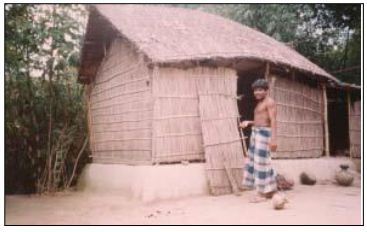
Semi-Pucca House
Foundation: Earthen plinth; Brick perimeter wall with earth infill; Brick and concrete.
Walls: Bamboo mats; CI sheet; Timber (sometimes split bamboo) framing. Earthen walls in some areas. Sometimes part or full brick.
Roof: CI sheet with timber framing (sometimes split bamboo).
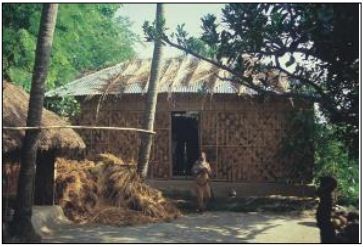
Pucca House
Foundation: Brick and concrete.
Walls: Brick.
Roof: Reinforced concrete (RC).

Problems of Rural Housing
The rural houses are mostly built with the locally available materials like mud, bamboo, tiles and thatches that are not durable and easily get damaged due to heavy rain and wind blows. Due to the heavy wind velocity and the uplift forces developed by cyclone the pyramidal shaped roofs and the projected eaves of the roof are also damaged. The light roof structures having inadequate
―J‖ bolts, absence of wind bracing and lack of ties, inadequate sheet thickness, fastening and insufficient frequency of the fasteners contribute to the damages, even the permanent houses constructed with RCC and brick walls are also affected due to the excessive corrosion of steel in the structures. The roof slab having inadequate thickness of roof concrete and low self-weight which causes tension at the top due to the suction effect of the wind where hair line cracks develop, these RC concrete exposed to the atmosphere gets rusted and ultimately causes the roof to collapse. Heavy damages occur to the unsymmetrical houses compared to symmetrical plan about its both axis. Factors to decide the level of damage during disasters are the effects of wind tunnel on the streets and housing plan arrangements. The unreinforced masonry walls also fail due to excessive tension. Sometimes the timber rafter are destroyed by the white ants and losses its section and leads to collapse at the time of disasters. The unscientific installation of roof tiles, doors and window latches, hinges and bolts, are vulnerable hardware and fasteners during the disaster. The cantilever parapets and the light weight verandah roof, improper connections of walls with footings are the most susceptible to high speed wind. The siting of building on the terrain conditions like hills, valley, ridges in the windward side, leeward side are the factors influencing the damage level of structure (Mahendran and Hussain, 2010).
Risks and Vulnerabilities of Housing in Bangladesh
Any given risk or disaster event is distinguished by its geographic location and setting. These are important keys to the origins of danger, the forms of damage and whom they most affect. They are critical for the appropriateness and deployment of organized response (Hewitt, 1997).
Cyclone Prone Communities
For generations, cyclones and tidal surges have frequently devastated lives and property in coastal areas of Bangladesh. Rural communities that are located on lowlands or in unprotected and unsheltered, low-lying coastal areas or river floodplains are mostly considered to be vulnerable to cyclones. The vulnerability of a human settlement to a cyclone is determined by its sitting, the probability that a cyclone will occur, and the degree to which its structures can be damaged by it. Generally, the poor and the marginalized, who cannot afford to obtain a land in a safe area, to build a house with proper guidance and building materials and to have an alternate source of livelihood are forced to settle down in these vulnerable areas that pose serious threat to cyclones. Houses are considered vulnerable if they cannot withstand the forces of high winds.
Generally, lightweight structures with wood frames, especially older buildings where wood has deteriorated and weakened the walls, houses built with temporary materials, poor joints and bracings, without any design guidance and construction assistance are those most vulnerable to cyclones. Houses made of unreinforced or poorly-constructed concrete block are also vulnerable unless they are anchored properly to the ground. The degree of exposure of land and buildings will affect the velocity of the cyclone wind at ground level, with open country, seashore areas and rolling plains being the most vulnerable. Certain settlement patterns may create a “funnel effect” that increases the wind speed between houses, leading to even greater damage (Agarwal, 2007).
Flood Prone Communities
Human being exists in this world in an adopted ecological relationship with the surrounding environment and has to live with a variety of natural hazards which threaten life and property.
Flood is the most common type of hazards and the cause of most natural disasters affecting society. Flood is the perennial problem for Bangladesh. Every year flood causes enormous damage to the people and property of the country. Particularly in the rural areas of Bangladesh, the housing for the majority of the population is very weak and incapable of withstanding the extreme loads generated during these natural calamities (Al-Hussaini et al., 1999). As the population in the rural areas is increasing, people are moving towards the floodplains for settlement that makes them more exposed to damage due to recurrent flooding. To fulfil the requirement of accommodation, agricultural and marshy lands are used for housing; more houses are built neglecting water drainage system and proper sanitation. This makes the settlement more and more vulnerable.
The impact of floods to housing is due to several reasons:
- a) Flood depth,
- b) Flood duration,
- c) Uplift due to soil saturation and
- d) Horizontal force created by flood waves or currents.
Direct flood hazard is associated with other types of secondary hazards such as high winds or storms, lightning, slope instability, ground settlement, etc. Floodwater can submerge buildings and cause various degrees of damage from staining of walls to structural collapse depending on flood depth and/ or duration and type of building (ADPC, 2005).
Landslide Prone Communities
Landslide is one of the neglected disasters in Bangladesh, as these take place in isolated and dispersed locations and do not create big headlines as earthquake, flood or cyclone does. The cumulative effects of landslides, however, in terms of lives, properties and infrastructure have been quiet substantial. There have been instances when many settlements in hilly slopes have gone into complete oblivion and many rural and urban settlements have been very severely affected due to landslides.
Common attribution of vulnerability of mountain people in Bangladesh are poverty, landlessness, inaccessibility to natural resource base, illiteracy, isolation, backwardness and fragility stemming from rugged terrain and harsh climates; in turn, risks are linked with greater proneness to geophysical extremes, unfriendly agricultural practice, increasing population and scarce resources (Sarkar and Rashid, 2013). Due to population increase the rural poor are unable to afford proper housing and live in informal settlements. These informal settlements are built on vacant government land or private vacant land located in low-lying areas, river banks, foothills and valleys vulnerable to natural disasters. Specially, from 1990 rural people started to migrate from different parts of the country to the hilly region as abundant land and natural resources are available there and migrated people face less struggles for livelihood and living space. As these people from flat plain do not have any understanding about living in the hills and hill ecosystem, they unknowingly welcome threats of landslide by unsustainable land use, vegetation, disrupting natural drainage of a hill etc. In areas prone to seismic hazards, the large number of building of variable quality, many of which poorly constructed or badly maintained, will pose high risk to lives. The vulnerability of people living or working in such structures is bound to be high. A growing population can likewise put pressure on natural resources such as agricultural lands and forests. With the limited land for food production, it may result in the opening or encroachment of forestlands, not only for food production but for settlements as well. Deforestation can result to increase in landslide hazard intensity or frequency in the long run (Sarkar and Rashid, 2013).
